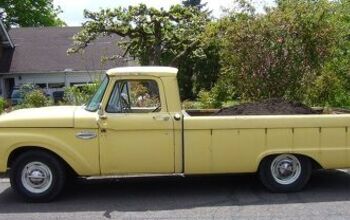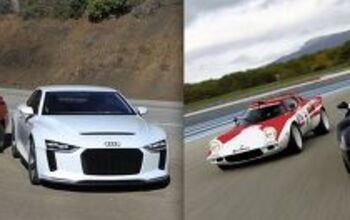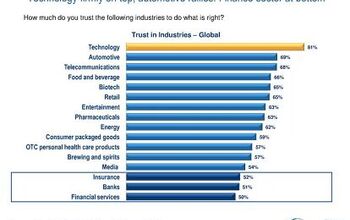Ask the Best and Brightest: What Do You Do If You Cannot Avoid an Accident?

I’m pretty good at taking tests. The problem is, with some tests that you take, success is not attained by giving the logically correct answer but rather by regurgitating the answer the test giver wants. I forget that sometimes. When the Michigan Secretary of State’s office told me that I needed to take a written test to continue to have the privilege of driving, on one question I forgot the proper test taking strategy was to determine what some bureaucrat in Lansing wanted me to think. Instead I just read the question, parsed its logic, and gave the same answer that I’ve given my now-adult children concerning the same driving situation. Wait. That’s a fib. I didn’t just read the question, parse etc. The question and possible answers intrigued me enough that I jotted them down on an envelope I had with me. They were unclear enough that I wanted to run them by the other TTAC writers and the Best and Brightest to get your opinions. Here’s the question:
Q. If you cannot stop before hitting another vehicle it’s usually best to:
A. Gradually slow down and hit the other vehicle.
B. Try to steer around the vehicle and avoid braking hard.
C. Release the accelerator and apply the brakes as hard as you can.
According to the bureaucrats in Lansing, the correct answer is B, try to steer around the vehicle and avoid braking hard. However, the question is about an unavoidable collision, you can’t really steer around a vehicle that you are indeed going to hit, can you? Now if I think about it, I can understand why trying to steer around a collision might mitigate that collision by avoiding head-on impact but that really doesn’t answer the actual question that was asked. I’ve been taught that, yes, under almost all circumstances you do want to maintain control and never, ever, lock up the brakes (well, with modern ABS that’s hard to do, so let’s say “stand on the brakes”), except for when you’re certain that you are going to hit another car or some other large object. When you absolutely can’t avoid a collision, I’ve been taught that you should do what you can to scrub off as much speed as possible before impact and that the best way to do that is to apply the brakes as hard as you can. That would make C the correct answer. Yes, you may lose control as the brakes lock up and the tires start to skid, but that’s the maximum coefficient of friction that you can create at that moment. It may not be a very controlled stop, but skidding to a stop can slow you down in a hurry. If you ice skate, think hockey stops. Locking them up is what you can do that will retard your speed quickest, it’s also just about the only thing you can do, or that’s what I’ve been taught. So what do you say the appropriate response is in the event of an unavoidable collision, try to continue to steer around the collision and avoid hard braking, or stand on the brakes and reduce impact speed as much as possible?
Ronnie Schreiber edits Cars In Depth, a realistic perspective on cars & car culture and the original 3D car site. If you found this post worthwhile, you can dig deeper at Cars In Depth. If the 3D thing freaks you out, don’t worry, all the photo and video players in use at the site have mono options. Thanks for reading – RJS

Ronnie Schreiber edits Cars In Depth, the original 3D car site.
More by Ronnie Schreiber
Latest Car Reviews
Read moreLatest Product Reviews
Read moreRecent Comments
- EBFlex Amazing they finally made a good decision in NY. Golf clap
- EBFlex Not at all. The solution to congestion is to make more lanes for vehicles. No bike lanes, no trains, none of it. Another solution is to make your public transit a place people actually want to be and not a septic tank of violent criminals and drug users.
- Firehawk I had two of these with lean and misfire codes. He changed the plugs you say??? has he inspected them? One of the two times it was a brand new plug that cracked. The other lean condition was some random threaded hole on the bottom of the throttle body that needed to be closed up, whatever was in there came out and was letting a lot of unmetered air into the intake. I love the Mark VIIIs my 97 and 98 would still be here today if it weren't for other drivers and their proclivity for hitting things. 97 was rear ended and totaled the 98 was t-boned while parked. Moved on to bigger Lincolns. Got an MKT and Aviator now.
- Seth1065 Hell No, why should I as a driver have to pay for the subway repairs? I already pay over $250 a month in tolls to get into NYC, ( all of it not just Midtown) ( do not tell me to move closer I am less than 20 miles from midtown) the roads are crap as it is now , the trains are not much better and I have no faith in the port Authority ( referred around metro NY as the 51 state) to spend the money properly. They want no drivers in midtown , they already allowed over a 1000 parking spots to be taken up by restaurants out door dining. Most folks can not afford to live in midtown ( and the ones who can may not want to live in a city) but the city wants its workers back in their office buildings. People need to drive into the city for various reasons and they work there, want to eat at a restaurant trucks need to deliver food there, they will pay and pass teh bill on to the restaurant who will pass it on to the consumer. I did laugh yesterday when I read NYC has already spent a half billion dollars on the trackers. BTW I am pretty sure port authority personnel do not pay for their expats so who should they car. Show me a plan where everyone pays for this , train riders, subway riders, car drivers and I may agree but until then I will just not go to the city as often. I do think this will pass around Nov. 8 after election day. and a train to midtown from LGA , yeah that will happen , cost ten billion and 90 years. they can not even finish the 2 ave subway and that's been going on about 75 years at least.
- Bkojote Hi, actual city planner here. Congestion pricing In NYC? Yes. Hell yes. Absolutely hell yes. Like empirically we've already got proof the answer is yes, there's not even a discussion about this anymore, the Robert Moses experiment is 50+ years old. We might as well be arguing if the earth is flat. Now build the freaking rail link from LGA airport I don't want to be inhaling car freshener fumes from my crappy Uber.


































Comments
Join the conversation
To me the two scariest situations is driving are these: 1. In city driving, say in a four-lane road, low-speed, two lanes in each direction. With intersections every block, either with lights or not. You're in the right hand land and a line of cars is stopped in the left hand lane. Are they stopped for a pedestrian crossing or because someone is turning? Double jeopardy - someone not looking properly decides to dart into your lane because he doesn't want to wait behind the turner. Basically you have no choice but to slow down. 2. On the highway/freeway, if you are changing lanes, either to the left or right, at normal speed, and someone in the lane next to the lane you are changing into decides he wants to be in the same spot. Since I have my mirrors set correctly and do a shoulder check to the immediate left or right of me before changing lanes, in the very short time interval between checking and moving into that lane, the other person decides to do the same. Only if one or both of you notice this is happening will the situation work out. What do you guys think?
OK, I am coming a bit late to this party but, for what is worth, here is my input; Sheldon Cooper in Big Bang Theory would have a field day with this one. The question is: "If you cannot stop before hitting another vehicle it’s usually best to:" MY question is: Usually best for WHOM or WHAT? Best for my own selfish preservation needs? Best for minimizing general carnage? Best for avoiding death or injury of other parties? Best for minimizing legal liabilities? etc. etc. etc. In short, the question is so utterly vague and every crash scenario so different (road conditions, speed, other traffic and a hundred other variables) that to get the "correct" answer you have to guess what the examiner WANTS you to answer. In no way does the knowledge of the "correct" answer to this question further the general safety of new road users.